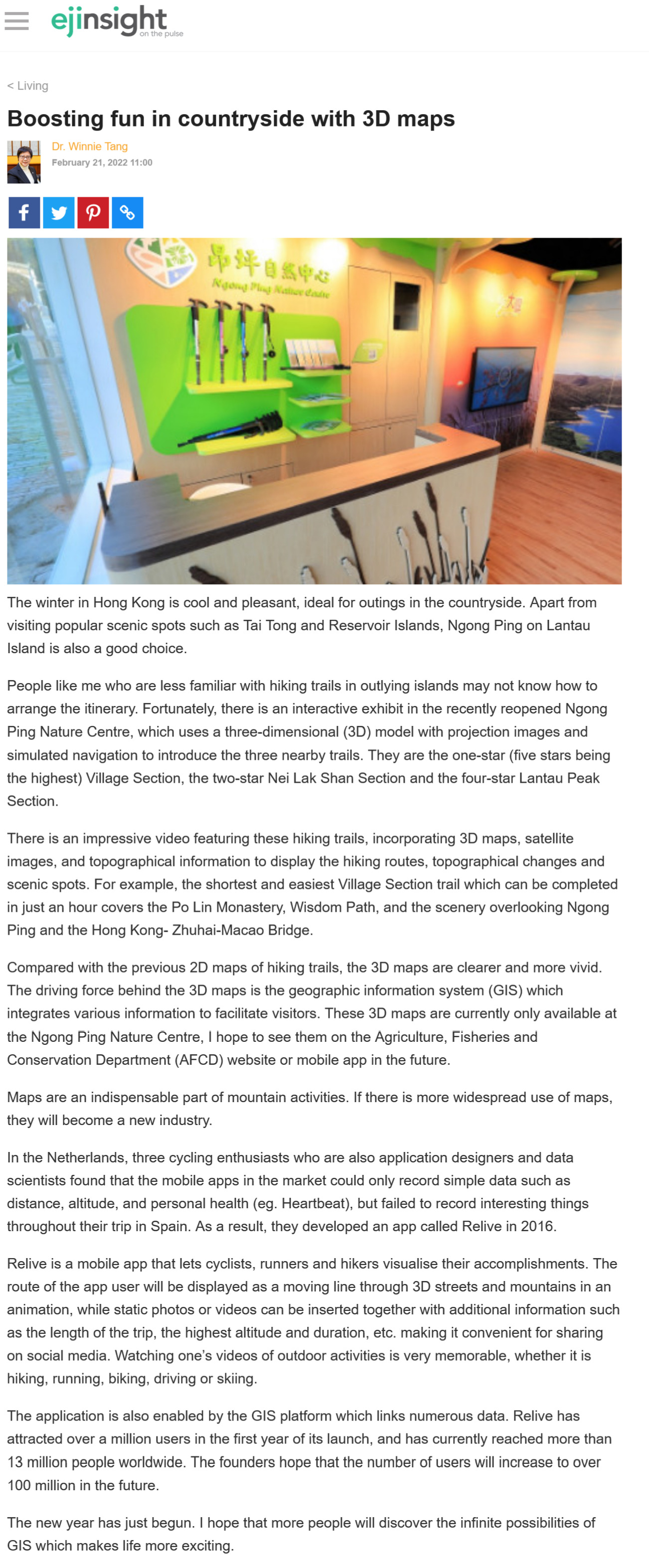網上版請按此

Boosting fun in countryside with 3D maps
The winter in Hong Kong is cool and pleasant, ideal for outings in the countryside. Apart from visiting popular scenic spots such as Tai Tong and Reservoir Islands, Ngong Ping on Lantau Island is also a good choice.
People like me who are less familiar with hiking trails in outlying islands may not know how to arrange the itinerary. Fortunately, there is an interactive exhibit in the recently reopened Ngong Ping Nature Centre, which uses a three-dimensional (3D) model with projection images and simulated navigation to introduce the three nearby trails. They are the one-star (five stars being the highest) Village Section, the two-star Nei Lak Shan Section and the four-star Lantau Peak Section.
There is an impressive video featuring these hiking trails, incorporating 3D maps, satellite images, and topographical information to display the hiking routes, topographical changes and scenic spots. For example, the shortest and easiest Village Section trail which can be completed in just an hour covers the Po Lin Monastery, Wisdom Path, and the scenery overlooking Ngong Ping and the Hong Kong- Zhuhai-Macao Bridge.
Compared with the previous 2D maps of hiking trails, the 3D maps are clearer and more vivid. The driving force behind the 3D maps is the geographic information system (GIS) which integrates various information to facilitate visitors. These 3D maps are currently only available at the Ngong Ping Nature Centre, I hope to see them on the Agriculture, Fisheries and Conservation Department (AFCD) website or mobile app in the future.
Maps are an indispensable part of mountain activities. If there is more widespread use of maps, they will become a new industry.
In the Netherlands, three cycling enthusiasts who are also application designers and data scientists found that the mobile apps in the market could only record simple data such as distance, altitude, and personal health (eg. Heartbeat), but failed to record interesting things throughout their trip in Spain. As a result, they developed an app called Relive in 2016.
Relive is a mobile app that lets cyclists, runners and hikers visualise their accomplishments. The route of the app user will be displayed as a moving line through 3D streets and mountains in an animation, while static photos or videos can be inserted together with additional information such as the length of the trip, the highest altitude and duration, etc. making it convenient for sharing on social media. Watching one's videos of outdoor activities is very memorable, whether it is hiking, running, biking, driving or skiing.
The application is also enabled by the GIS platform which links numerous data. Relive has attracted over a million users in the first year of its launch, and has currently reached more than 13 million people worldwide. The founders hope that the number of users will increase to over 100 million in the future.
The new year has just begun. I hope that more people will discover the infinite possibilities of GIS which makes life more exciting.
Dr. Winnie Tang
Adjunct Professor, Department of Computer Science, Faculty of Engineering; Department of Geography, Faculty of Social Sciences; and Faculty of Architecture, The University of Hong Kong